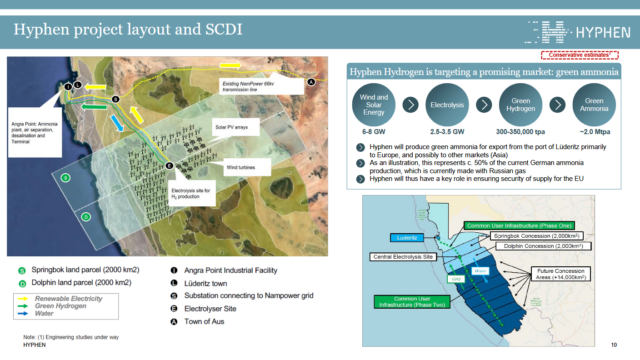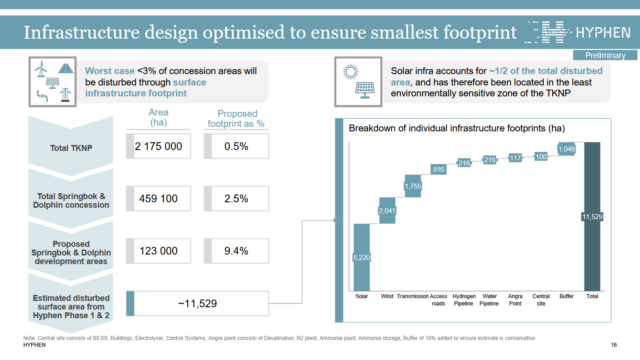First step in establishing Namibia’s renewable hydrogen and ammonia industry
By Kevin Rouwenhorst on November 21, 2024
Hyphen Hydrogen Energy

Click to enlarge. Project Hyphen, the first step in Namibia’s green hydrogen industrialization pathway. From Giuseppe Surace and Toni Beukes, Hyphen Green Hydrogen Project SCDI, Namibia (Oct 2024).
In our October episode of Project Features, Toni Beukes and Giuseppe Surace from Hyphen Hydrogen Energy joined us to discuss Hyphen’s renewable ammonia project in Namibia. The recording is available on the AEA’s website, and you can also download the speaker presentations.
Namibia has some of the best combined solar and wind resources globally, allowing for high-capacity, low-cost renewable ammonia production. Renewable ammonia projects in Namibia are being developed in two regions, in the Tsau Khaeb national park toward the south (close to Lüderitz and Angra Point), and near Walvis Bay on the central Namibian coast. Namibia is also a stable democracy. This is highly relevant for investors, because the geopolitical situation determines the bankability of capital intensive, mega-scale projects such as renewable ammonia plants.
2 million tons of renewable ammonia in two phases, with room to grow
First announced in 2021, Hyphen Hydrogen Energy is developing its renewable ammonia project in the Lüderitz Area. Hyphen Hydrogen Energy aims to produce a total of 2 million tons per year of renewable ammonia, developed over two phases. In 2021, Hyphen Hydrogen Energy secured two plots of land from the government, each on a 40 year lease. These plots of land are 2000 km2 each within the Tsau Khaeb national park, known as the “Springbok” and “Dolphin” concessions.
A further 14,000 km2 has been designated by the Namibian government for future renewable hydrogen and ammonia production, resulting a potential total ammonia production capacity of 9 million tons per year.
About three quarters of the current project structure is held by Nicholas holdings, with experience in infrastructure projects in South Africa and experience in raising capital, and Enertrag, which is a German renewable energy company. The Government of Namibia is an equity partner in the project for about a quarter of the project, while also receiving dividend for the land lease (around 10-12 million euros over the 40 year lease period).
Hyphen Hydrogen Energy aims to produce the 2 million tons of renewable ammonia from 3 GW of installed electrolyzers, fed by 3.5 GW solar (32% capacity factor, around 5000 hectares) and 4.0 GW wind (60% capacity factor, around 600 wind turbines). The electrolyzer plant is located centrally in the Springbok and Dolphin concessions, producing hydrogen about 70 km from the Lüderitz port area.

Click to enlarge. Overview of the Hyphen Hydrogen Energy in the “Springbok” and “Dolphin” concessions. From Giuseppe Surace and Toni Beukes, Hyphen Green Hydrogen Project SCDI, Namibia (Oct 2024).
Hydrogen will be sent to the port area by pipeline, while desalinated water is transported back from the port area to the electrolyzer plant in an adjacent pipe. Nitrogen purification from air and the ammonia production, storage and handling occurs in the port area. Electricity is also transported to the port area for the nitrogen purification and the ammonia production, storage, and handling. As shown to the left, these pipeline “spines” will run centrally through the two land concession areas, as well as through the future concession areas.
The first phase with 1 million tons of annual renewable ammonia production is planned for the end of 2028 or early 2029. About 15,000 jobs are expected during construction, and, once operational, 3000 workers are expected to be required permanently. About 90% of the jobs are expected to be filled by locals, and the project aims for 30% local content in the supply chain.
FEED is expected to start toward the end of 2024 or in early 2025, with an aim for FID in 2026. The year 2025 will be devoted to offtake agreements and commercial discussions, with various offtake MoU’s previously signed. The project is designed for export, with a main focus on export to Europe with RFNBO compliance (Renewable Fuels of Non-Biological Origin).
ESG aspects of renewable ammonia production: minimizing project footprint
The total investment for the two phases is over ten billion USD, roughly equivalent to Namibia’s current annual GDP. Also, the total electricity generation is roughly 9-10 times the current Namibian electricity grid, indicating the sheer size of the project. Thus, electricity will be supplied to the national grid infrastructure, decreasing reliance on electricity imports from South Africa. Also, fresh water will be supplied to the community in the Lüderitz area, which is currently a water scarce area.

Click to enlarge. Overview of the project’s infrastructure footprint. From Giuseppe Surace and Toni Beukes, Hyphen Green Hydrogen Project SCDI, Namibia (Oct 2024).
About 42% of Namibia’s landmass is under conservation management, with environmental production included in the constitution. Minimizing the environmental impact of the renewable ammonia project is therefore critical, and extensive work has gone into minimizing the project footprint. It is estimated that less than 3% of the land area of the Springbok and Dolphin concessions will be disturbed by the project. Nearly half of that is solar PV panels, followed by wind turbines and transmission infrastructure. Hyphen plans for the physical infrastructure footprint (including roads) to be a tiny 115 km2 of the total allocated 4000 km2 in the park.
The first project phase focuses on export in the form of ammonia. The strategic location of the project near Lüderitz may also allow for ammonia bunkering for ammonia-fueled vessels. Subsequent phases may also serve local industries, for example to produce value-added products like steel or fertilizers. This allows the local skill base to be built alongside the local industry, given the low current industrial base that currently exists in the country. Namibia has a significant number of unemployed graduates, which may be retrained for the renewable energy industry via an apprenticeship or internship to build the relevant skills. The renewable energy industry offers investments in infrastructure, education, employment, and royalties, as described in the Socio-Economic Development (SED) strategy set up alongside active stakeholder engagement.